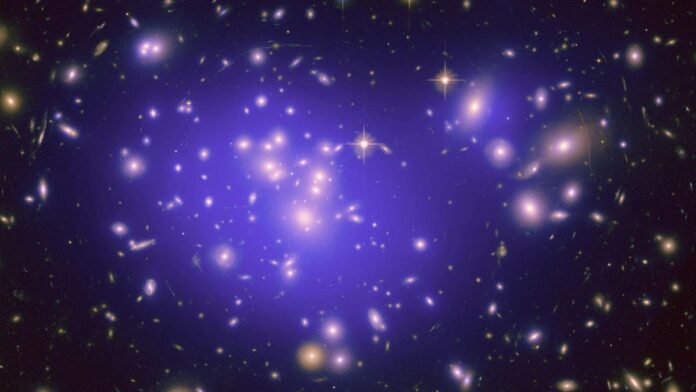Observations suggest that the intergalactic gas in our universe is a little hotter than it should be.
Recently, a team of astrophysicists have used sophisticated computer simulations to propose a radical solution: an exotic form of dark matter known as “dark photons” could be heating the place up.
These strange particles would be the carriers of a new, fifth force of nature that normal matter does not experience, but occasionally these dark photons can flip their identities to become regular photons, providing a source of heat.
Related: Dark matter particle that may finally shed light on cosmic mystery the ‘best of both worlds,’ scientists say
Feeling neutral
We could find such dark photons by observing the intergalactic gas using what’s known as the Lyman-alpha forest. When we observe light from a distant, bright object, like a quasar (glowing objects powered by black holes at the centers of distant galaxies), there is a series of gaps in an otherwise smooth spectrum of light from that faraway object.
Here’s why: that light has to filter through billions of light-years of gas to reach us. Occasionally that light will pass through a relatively dense clump of neutral hydrogen — a type of hydrogen that consists of one proton and one neutron, and which permeates gas clouds throughout the universe.
Most of that light will pass through unaffected, but a very specific wavelength of light will get absorbed. This wavelength corresponds to the energy difference needed to bump an electron from its first to its second energy level inside the hydrogen atoms.
When astronomers look at the light coming from that object, it will look otherwise unremarkable except for a gap at the wavelength of that specific energy transition, known as the Lyman-alpha line.
The light from the distant object will pass through multiple clouds and clumps of neutral hydrogen. The expansion of the universe causes the gaps to redshift to different wavelengths, with a new gap appearing at a different wavelength depending on the distance to the particular gas clouds.. The end result of this is the “forest”: a series of lines and gaps in the spectrum.
Getting hot in here
These Lyman-alpha gaps can also be used to measure the temperature of each gas cloud. If the neutral hydrogen were perfectly still, the gap would appear as an incredibly thin line. But if the individual molecules are moving, then the gap will widen because of the kinetic energy of those molecules. The hotter the gas, the more kinetic energy the molecules have, and the wider the gap.
In a paper appearing in November in the journal Physical Review Letters (opens in new tab), a team of astrophysicists have pointed out that by using this method, it seems that the clouds of gas that scatter between galaxies are a little too hot. Computer simulations of the evolution of those gas clouds predict them to be just a little bit colder than we observe, and so perhaps something is heating up those clouds that isn’t currently accounted for in our astrophysical simulations.
One possible explanation for this discrepancy is the presence of “dark photons” in our universe, the study authors claim. This is a very hypothetical form of dark matter, the mysterious, invisible substance that accounts for roughly 80% of all the mass in the universe, yet doesn’t seem to interact with light.
Since astronomers do not currently understand the identity of dark matter, the field is wide open with possibilities as to what it could be. In this model, instead of the dark matter being made of invisible particles (like a phantom version of electrons, for example), it would instead be made of a new kind of force carrier — that is, a type of particle that mediates interactions between other particles.
A warm and fuzzy darkness
The familiar photon is the force carrier of electromagnetism – it’s what creates electricity, magnetism, and light. Dark photons would be a force carrier for a new force of nature that does not operate at the usual scales in the usual scenarios (for example, in our laboratories or within the solar system, where we otherwise would have already observed it).
According to the study authors, the dark photons would still have a tiny bit of mass, and hence they could still account for the dark matter. Plus, because they’re force carriers, they may also interact amongst themselves and with other potential dark matter particles. In the models investigated by the team of astrophysicists, the dark photons are capable of one more trick: they can occasionally turn into a regular photon.
In physics terms, the dark photons can “mix” with regular photons, very rarely swapping identities. When they do, the newly created photon goes on to do what regular photons always do: Heat things up. The researchers performed the first ever simulations of the evolution of the universe, including the effects of these sneaky shapeshifting dark photons. They found that a particular combination of dark photon mass and the probability of changing into a regular photon could explain the heating discrepancy.
This result is a very far from a slam-dunk case for the existence of dark photons. A range of possibilities could also explain the Lyman-alpha results, like inaccurate observations or a poor understanding of (normal) astrophysical heating between galaxies. But it is an intriguing clue, and the results can be used as a springboard to continue exploring the viability of this exotic idea.
Originally published on LiveScience.com.
Follow us @Spacedotcom (opens in new tab), or on Facebook (opens in new tab) and Instagram (opens in new tab).

